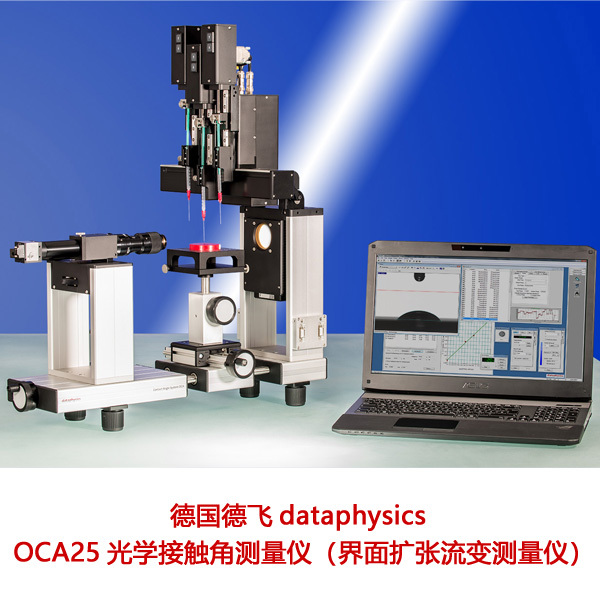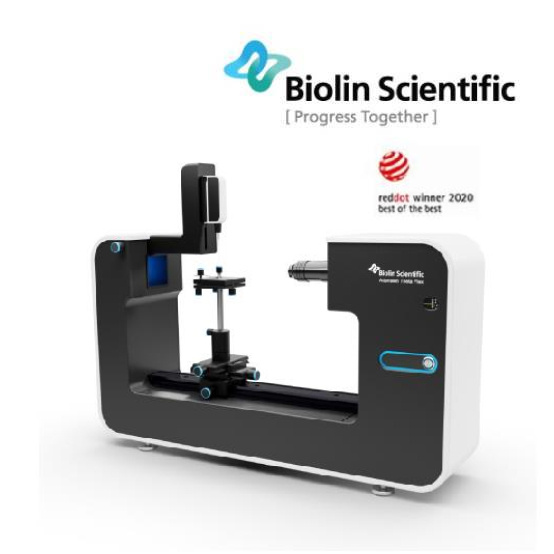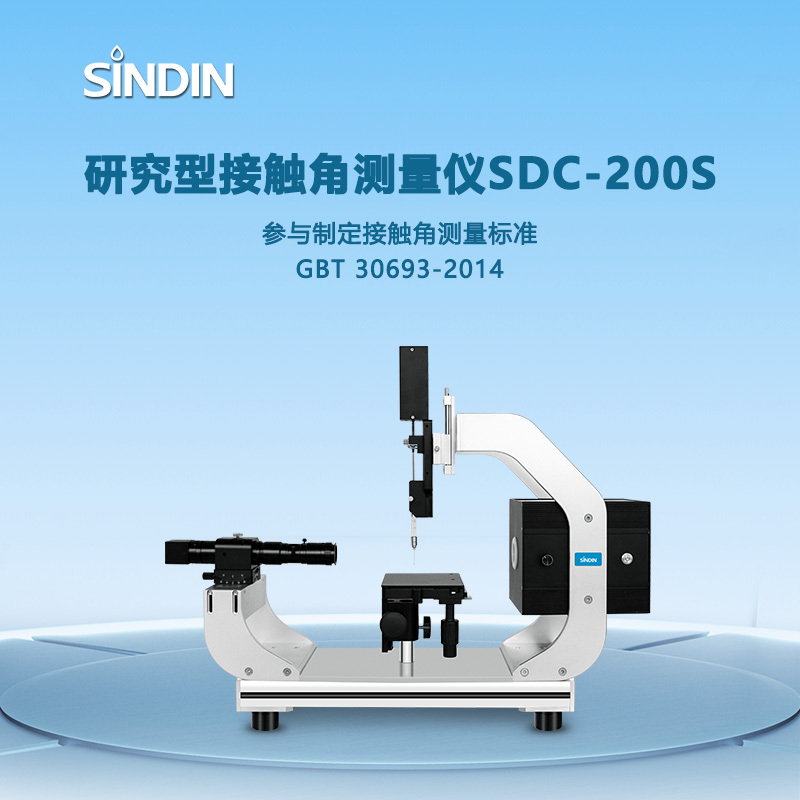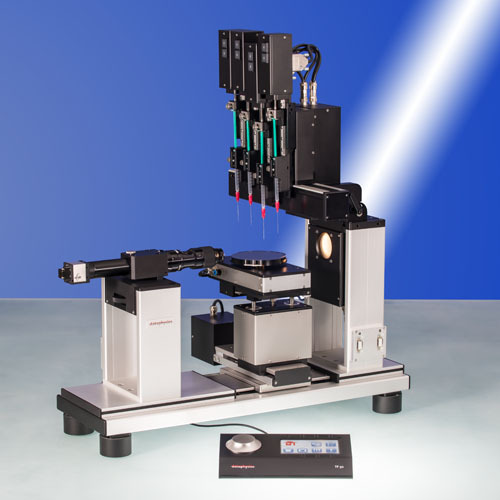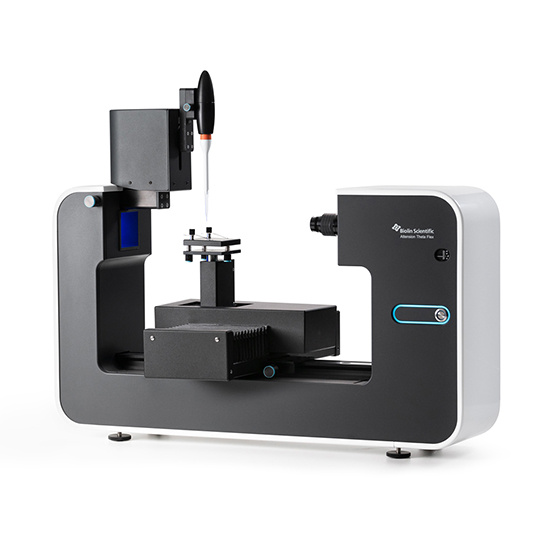
方案详情
文
浮选法以矿物粒子在溶液中的界面化学为基础,在初始浓缩过程特别是矿物加工工业中应用广泛。除此之外,在矿物加工工业中浮选法也常被应用于废水处理、油砂中沥青提取及纸张脱墨过程。该应用描述了如何利用Attension Theta振荡液滴模块(PD200)研究浮选工艺中的表面活性剂性能
方案详情

attension APPLICATION NOTE 1 1 Pulsating drop technique tocharacterize surfactant behaviorin flotation process This application note describes how Attension Theta pulsatingdrop module, PD200, can be used to study surfactant behaviorin flotation process. Introduction Flotation is widely used primary concentration process especiallyutilized in the mineral processing industry. It is based on theinterfacial chemistry of mineral particles in solution. In addition tomineral processing, flotation is also used in waste water treatment,extraction of bitumen from oil sand and paper deinking. The principle of flotation process is simple: In the flotation tank,fine bubbles are dispersed in the pulp containing finely groundedore particles. Depending on hydrophobicity of the ore particles,they are able to attach to the air bubbles. Thus, valuable ore islifted to the top of the tank from where they are skimmed off, whilegangue minerals stay in the pulp. The dispersed air bubbles playa key role in the process. Their properties are strongly influenced by the composition of the fluid medium that consists of water andflotation reagents, such as frothers, collectors, depressants, etc.Of all these reagents, frothers are surface active substances thateffect on formation and behavior of the air bubbles. The frothermolecules adsorb on the bubble surface creating an adsorptionlayer. During the adsorption the surface tension [y] decreases untilit reaches an equilibrium value.Under dynamic conditions thekinetics of adsorption and desorption of surfactants to and fromsolution have a major effect on the behavior of bubbles. Under-standing the rheological properties of the adsorbed layers isimportant for characterization of commercial surfactants. The dilatation rheology is an unique tool suitable to investigateequilibrium and dynamic properties of interfacial layers. Surfaceelasticity [E] of the interface defined by Gibbs: where A is the surface area. Only for pure elastic interfaces, thedynamic interfacial tension response [y(t)] follows immediately thearea change [A(t)] without any phase lag (Fig 1). However, ingeneral the interfacial tension follows the area change with acertain delay due to the various relaxation processes within theinterfacial layer, and between the interface and the adjacent bulksystem[1]. Figure 1. Response of the surface tension and bubble area for asinusoidal perturbation of a pendant drop [2]. To describe this surface property the complex surface dilatationalmodulus [E*] [2] can be written as where E' is called to storage modulus which is obtained as thepure dilatational elasticity and E" is loss modulus and is propor-tional to the viscous contribution [2] where n. is the surface dilatational viscosity and ω the circulartrequency. The capillary wave and oscillating bubble techniques were thefirst two methods developed to measure surface dilatationalelasticity. The bubble oscillation method developed by Lunkenhe-imer and Kretzschmar [4] uses harmonic interfacial disturbance tomeasure the surface dilatational elasticity. A small bubble isformed at the end of a capillary tip and a membrane is used tocreate harmonic oscillation (Figure 2). This technique allows tomeasurement of the surface dilatational elasticity at relatively hightrequencies. Figure 2. Adsorption kinetic of surfactant on a pulsating bubble. The modified pendant drop technique [5] works on the sameprinciple as the oscillation bubble method. The high resolutionand excellent accuracy (±0.1mN/m) provides a useful tool forstudies of dynamic of adsorption layers. The method can beapplied to liquid-gas as well as liquid-liquid interfaces. [6]. The Pulsating Drop Module provided by Attension is a compact,optional module to Theta optical tensiometer to measure surfacedilatational elasticity based on the modified pendant droptechnique. Case study: Investigation of dynamicproperties of air-water interfaces inpresence of different surfactants During the flotation process different frothers affect the recoveryof valuable minerals most probably by changing the interfacialrheological properties of bubble surfaces. The property of interfa-cial layer could effect on bubble sizeand/or attachment of particleto bubble surface. In this study the Attension Pulsation DropModule was used to investigate the effect of two well-knowncommercial frothers, Nasfroth 240 (NF240) and Dowfroth 250(DF250), on dilatational elasticity and viscosity of the bubblessurface. Even though the concentrations of the two solutions are identical(25ppm) the result shows different surface properties as it can beseen on Figure 3. The air/water interface created in presence ofDF250 shows high elasticity and viscosity compare to that createdin NF240 solution. The difference could be due to the differentchemical structure and molecular conformations of the twosurfactants. Figure 3. Dependence of dilatational elasticity (A) and dilatationalviscosity (B) from increasing oscillation frequency of water dropletin presence of 25ppm NF 240 (o)and 25ppm of DF 250 (o). Surfactants are widely used in flotation to generate smallerbubbles (ca. 0.5-3 mm) and to foster froth phase and stabilize it.Even though small bubbles play a major role in flotation perfor-mance, little is known about the effect of frothers on their forma-tion. Cho and Laskowski [7] studied the effect of frothers on bubblesize. They found that with increasing frother concentration the sizeof the bubbles decrease due to the resistance of bubbles tocoalescence. The ability of the frothers to prevent coalescencedepends on not just the concentration, but also the type of thesurfactant. Frothers have a particular concentration (critical coales-cence concentration; CCC) where the coalescence of the bubblesis completely prevented. The dilatational elasticity of air-water interface was studied withAttension Pulsation Drop Module in presence of NF240 andDF250 frothers. The aim was to investigate how the surfaceproperties are changed when the concentration of the frotherswas increased from below the CCC point to above the CCC point.The increasing concentration of surfactant causes different effecton surface elasticity in presence of the two different types offrothers as it can be seen on Figure 4. In NF240 solution theincreasing concentration causes higher elasticity due to thedecrease of surface tension. However in presence of DF250 withincreasing frother concentration the elasticity of the interfacedecreases. This phenomenon could be explained with the fastermolecule exchange. The higher the concentration, the faster theexchange and the lower the elasticity. Conclusions The pulsation drop technique is an accurate technique to investi-gate the rheological properties of interfaces with relatively highfrequencies. The dilatation rheology is an unique tool to charac-terize the elasticity of air-liquid or liquid-liquid interfaces underdynamic condition. The dynamic surface elasticity is able todemonstrate adsorption kinetics via pure dilatational elasticityand dilatational viscosity results. This technique is very valuablefor characterizing】commercialsurfactants useddinflotationprocess Frequency (Hz) Figure 4. Change of dilatational elasticity with increasingoscillation frequency in presence of increasing concentration ofNF 240 (A) and DF 250 (B). The used concentrations are 8ppm(blue), 25ppm (dark grey) and 100ppm (light grey). ( References ) [1] R. Miller, J.K. Ferri, A. Javadi, J. Kragel, N. Mucic and R.Wustneck, Colloid Polym Sci (2010)288:937 [2] R. Myrvold and F.K. Hansen, J Colloid Interface Sci (1998)207: 97[3] R. Miller and L. Liggieri, "Progress in colloid and interfacescience: Interfacial rheology", vol 1. Brill, Leiden (2009) [4] K. Lunkenheimer and G. Kretzsclunar, Z. Phys. Chem., (1975)256:593 [5]R. Miller, Z. Policova, R. Sedev.,and A.W. Neumann, Colloids &Surfaces, (1993) 76: 179 ( [6 ] S.S. Dukhin, G . Kretzschmar and R. Miller,"Dynamic of Adsorp- tion at Liquid Interfaces" Elsevie r ,Amsterdam (1 9 95) ) [7]Y.S. Cho,J.S. Laskowski, Int J Mineral Process (2002) 64: 69 Contact information ( At te ns i on Bio l i n Sci ent if ic Tie tajant i e 2 F I N - 0 21 3 0 Es po o, F i n lan d ) ( T E L + 3 58 9 5497 3300FA X +35 8 9 5 49 7333 3 i nf o@ a tte ns i o n. c omwww.a t t en s io n .co m ) ATTENSION AN
确定

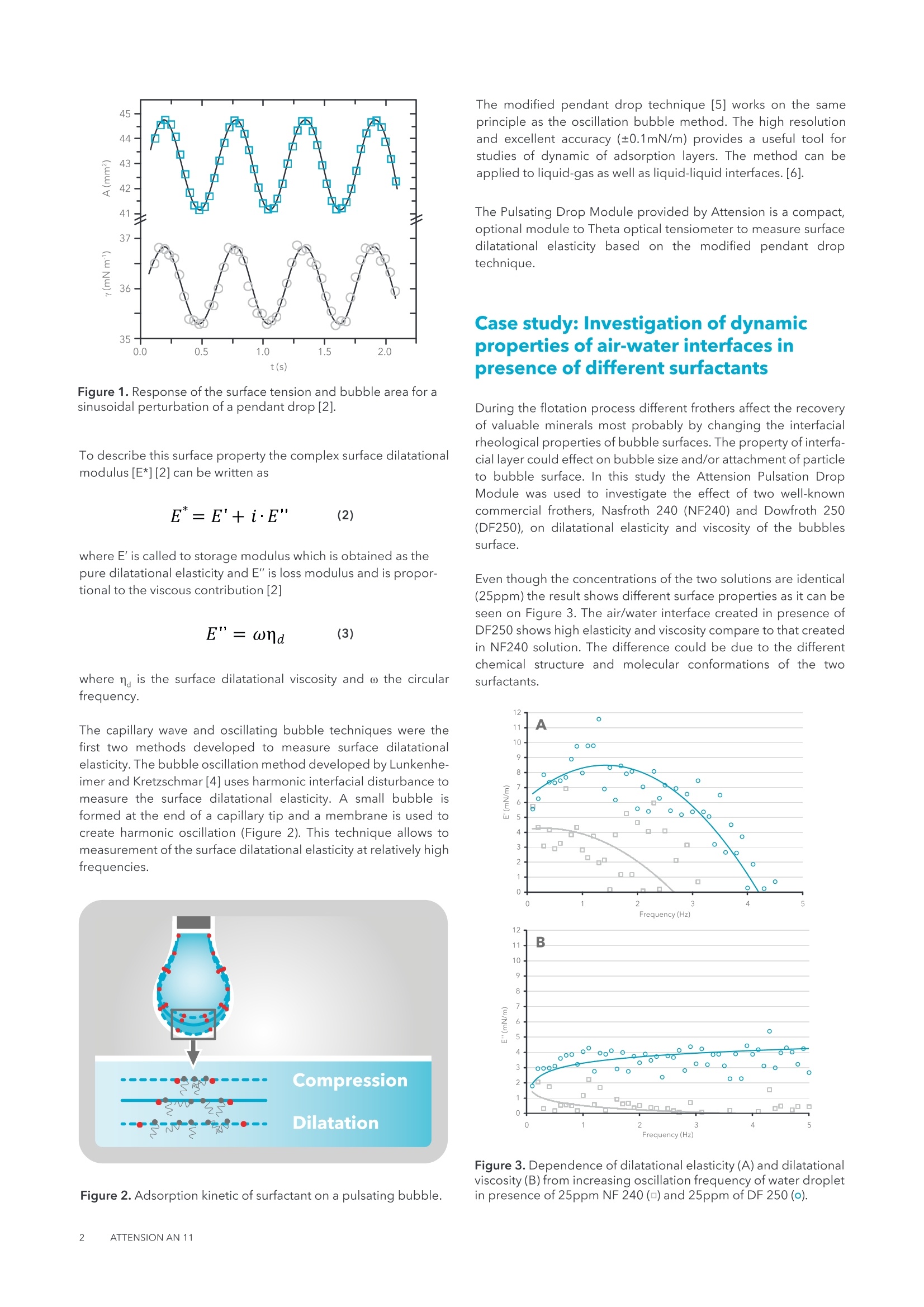
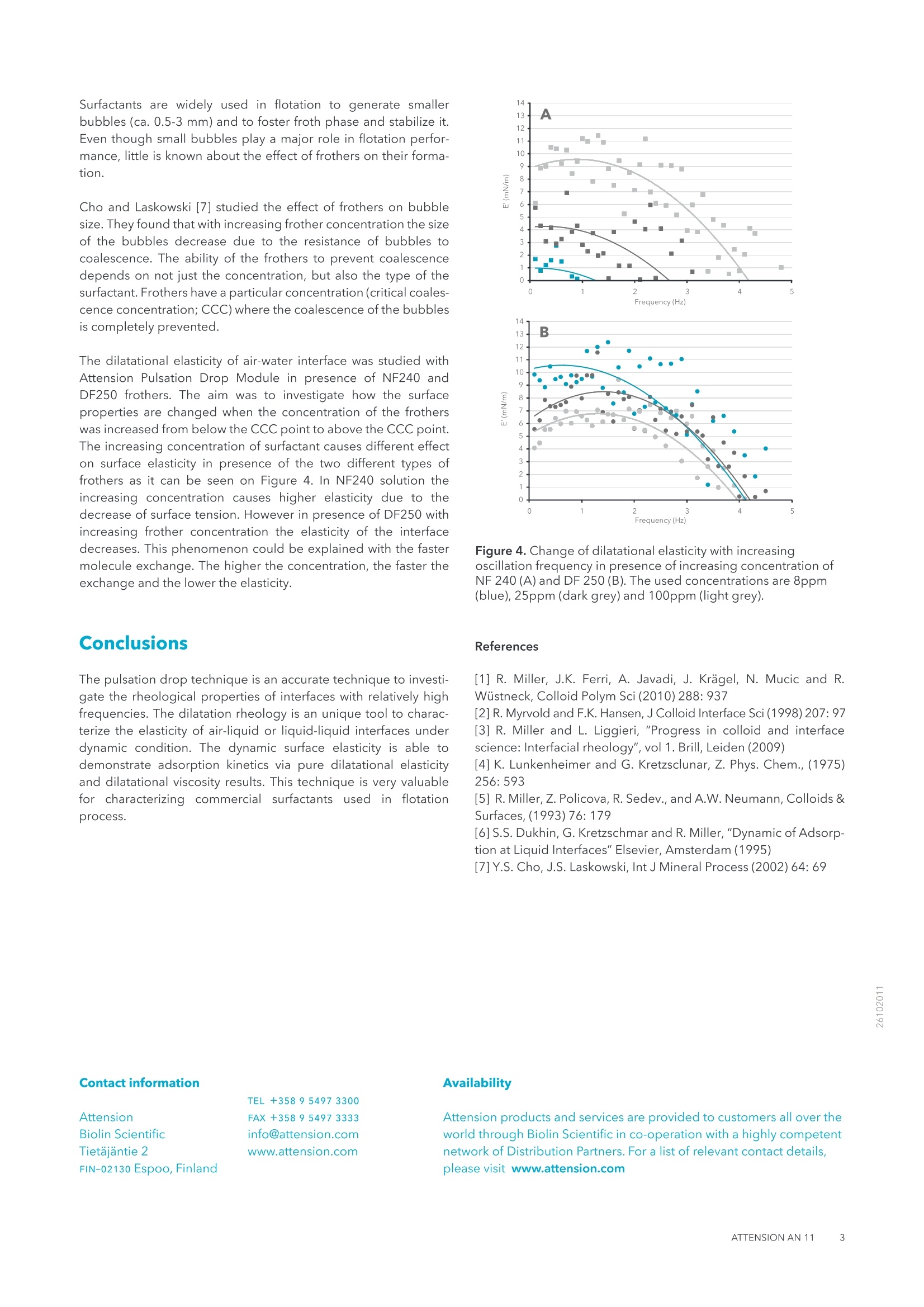
还剩1页未读,是否继续阅读?
瑞典百欧林科技有限公司为您提供《浮选工艺的表面活性剂中性能检测方案 》,该方案主要用于其他中性能检测,参考标准--,《浮选工艺的表面活性剂中性能检测方案 》用到的仪器有Attension Theta Flex 光学接触角仪、Theta Lite 光学接触角仪
推荐专场
相关方案
更多
该厂商其他方案
更多











